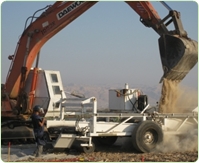Fortunately, you don’t have to know all this. You only have to know that ERW pose such a complex and widespread threat, the UN’s International Mine Action Standards (IMAS) must be quite flexible not to prevent demining work from being carried out in developing countries, where access to thorough training and technical equipment simply isn’t always available. As a consequence, many IMAS-certified operators use relatively basic and risky methods. Dozens of deminers are hurt or killed each year, and many projects are left unfinished. In contrast, by employing well-educated experienced operators and using the latest mechanical assets, we have cleared 34 million square metres from ERWs without a single accident. And we have finished 100% of every project successfully. So, if you want to be sure, you should really consider your options.
Our Crew
Including former members of elite military and police units, Maavarim’s team of deminers come with experience from some of the world’s most demanding environments. They are used to dealing with a vast range of different munitions and the ever-changing designs of improvised explosive devices, and they always keep an open mind to the unique nature of each new project. Furthermore, since our staff turnover is very low, the demining team remains tightly knit, working smoothly through bureaucratic procedures as well as in the field.
Logistics
Maavarim’s personnel are entirely self-sufficient, with transport, accommodation, tools and supplies provided in accordance with your HSE standards. All we need from you, is a brief.
Our Mine Action Services
Non-Technical Survey (Impact Survey)
Maavarim always base mine clearance work on thoroughly conducted surveys, initiating each project by interviewing locals and former combatants for a non-technical survey (usually not involving physical examination of the ground). All testimonies are then cross-checked against detailed mapping of the project area. With all this information at hand, the non-technical survey will conclude by declaring the area to be safe or classing it as a Suspected Hazardous Area (SHA) or Confirmed Hazardous Area (CHA).
Technical Survey
A technical survey of any SHA ensues, as a general rule using mechanised assets for the first and most dangerous entry. This will either clear the area from suspicion or render a CHA classification.
Clearance
Finally, all CHA are cleared from mines, again using mechanised assets whenever possible. Based on terrain, area covered and expected findings, the most efficient choice can be anything from ground-penetrating radar and remote-control underwater cameras to robotic or manned armoured vehicles with crushers, tillers, chains or flails. K9 units and deminers with metal detectors and the latest protection gear follow to ensure that no ERW remain for the mandatory quality assurance and control. Any
Underwater Clearance
Notably, surveys sometimes indicate a presence of ERW in aquatic environments, and you’ll be glad to know that Maavarim have a team of navy-trained divers to deal with such threats. Using specialised equipment, we can secure marine areas as well as rivers and lakes. Our ROV operators can even work in the deep sea. So, no matter where mines are found, Maavarim will clear them for you.
Battle area clearance (BAC)
When surveys show that an area is free from mines but contains quantities of conventional ammunition, a systematic battle area clearance (BAC) takes place. Given the more stable nature of conventional ammunition, this is considerably less involved than demining, but BAC is still subjected to the same rigorous quality assurance and control at the conclusion of the project.
Explosive ordnance disposal (EOD)
All unexploded ordnance (UXO) collected during demining or BAC is destroyed or disarmed through a process called explosive ordnance disposal (EOD), and Maavarim’s operating procedures guarantee that this is carried out in a perfectly safe and environmentally friendly manner.
Stockpile destruction
Larger amounts of surplus or abandoned UXO (AXO) are disposed of through stockpile destruction. This can involve industrial demilitarisation, in which munitions are dismantled and recycled, or open burning / open detonating (OBOD), in which munitions are destroyed in a field. As with EOD, Maavarim’s strict safety and environmental standards ensure that the optimal method is used in each instance.
Quality management (QM)
All projects undertaken by Maavarim are entirely transparent, with real-time monitoring made available through our GIS department. They are also continuously subjected to quality assurance to ascertain that standard operating procedures are adhered to, and at the conclusion of each project, our stringent quality control will certify that an area is safe before land is released to locals and developers. Exceeding the international mine action standards, our quality control is also offered as a standalone service to other mine action companies and organisations. The importance of rigorous quality control can obviously not be overstated; any doubts as to whether an area is safe will harm trust and provide an obstacle to progress.
Mine risk education (MRE)
With 80% of the 15,000-20,000 annual mine casualties being civilians and anywhere from 30 to 60% of these being children, mine risk education is of paramount importance to affected local populations. Maavarim offers education that not only complies with IMAS but also draws on our long experience and technical knowledge in the field. Over time, we have found that different audiences require different angles to best understand and heed the advice given.





